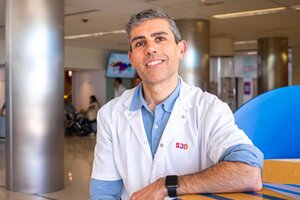Pediatric asthma affects 10% of children and progresses with age
Today, May 6th, is World Asthma Day, established thanks to the Global Initiative for Asthma (GINA) in 1998. The day's goal is to promote awareness of the disease, encourage the availability of effective treatments, and improve the quality of life of those affected. To raise awareness of this disease, we interviewed Dr. Jaime Lozano, pediatrician and head of the Allergology Section at the HSJDB and researcher in the Allergic Diseases in Childhood and Adolescence Research Group at the IRSJD.
What are the main current challenges in the diagnosis and treatment of asthma in the pediatric population?
Within pediatric asthma, we can find different forms of the disease depending on the intensity of symptoms, response to treatment, and impact on the child's quality of life. When symptoms are intense, require high levels of treatment, and affect quality of life, we refer to severe asthma. Currently, we have approved biological treatments for managing severe asthma in the pediatric population. However, one of the main challenges lies in the design of clinical trials, as they often do not consider the specific characteristics of pediatric patients. It is common to reuse trial designs originally intended for adults, which complicates the recruitment of child participants.
Additionally, many of these studies do not compare already approved therapies with each other but rather pit a drug against a placebo. This limitation has, in some cases, led to the approval of certain medications for children based on data extrapolated from adult studies-a practice that is far from ideal. For more information, you can consult the editorial published in Archivos de Bronconeumología (Spanish Society of Pulmonology and Thoracic Surgery - SEPAR): "The long road to biological treatment of asthma in pediatrics."
Another major current challenge in the treatment of severe asthma is selecting the most appropriate biological drug for each patient. At present, we have four approved biological treatments-an advanced type of therapy also used to manage other chronic and inflammatory diseases, such as rheumatoid arthritis or certain autoimmune conditions. Each of these drugs has specific response criteria, and it is often difficult to determine which of the four options is best suited to a patient's individual characteristics. This is undoubtedly another pressing challenge, and it would be important to promote more comparative clinical trials to generate robust evidence that can better guide therapeutic decision-making.
And what about general asthma? What challenges do we face?
Most treatments for general asthma are inhaled, and there is growing concern about their carbon footprint. Pressurized inhalers use propellants that are highly polluting. As an alternative, dry powder inhalers-much more environmentally friendly-are available, but they are not designed for use by very young children.
This situation has led many current studies to focus on the development of new molecules that can be delivered via dry powder inhalers. However, these options are not suitable for part of the pediatric population. At the same time, research is also being carried out to find less polluting propellants, but so far, these alternatives are not yet available in clinical practice.
Can you tell us about a specific project or study you're currently working on?
Right now, one of the most notable studies we are involved in, alongside Dr. Maria Cols, Head of the Pulmonology Department at HSJDB, is the SPACE project (Severe Paediatric Asthma Collaborative in Europe). This European initiative aims to improve care and research on severe asthma in children and adolescents aged 6 to 17 years. The main goal of SPACE is to create a European registry collecting clinical data from children with severe asthma treated in specialized centers. This database will support research studies and initiatives to improve the quality of medical care across Europe.
Additionally, SPACE seeks to create a network of expert professionals-both researchers and clinicians-working together to set research priorities and advance the understanding and treatment of this disease. The initiative also aims to encourage the participation of young researchers and healthcare professionals in the field and facilitate access to European or industry funding to develop new studies and projects.
In your opinion, what are the next opportunities in pediatric asthma research?
One of the most relevant future opportunities is to promote more clinical studies that provide data on the natural evolution of asthma. For example, we need to better understand whether asthma diagnosed during childhood can go into remission in adulthood. Despite its high prevalence, we currently lack sufficient evidence to clearly answer this question.
Moreover, as mentioned earlier, we also need to expand our understanding of how patients respond to the different available biological therapies. Having more data would allow us to more precisely determine which treatment is most appropriate for each patient and when to use it. Lastly, another pending research challenge is to better define how long treatment should be maintained once it has been initiated.
What message would you like to share for World Asthma Day, especially with families?
I would tell families that although asthma is a very prevalent disease-affecting 10% of the pediatric population-it can currently be effectively managed with the right treatment. With proper monitoring, children with asthma can lead completely normal lives.

Most treatments for general asthma are inhaled, and there is growing concern about their carbon footprint.
